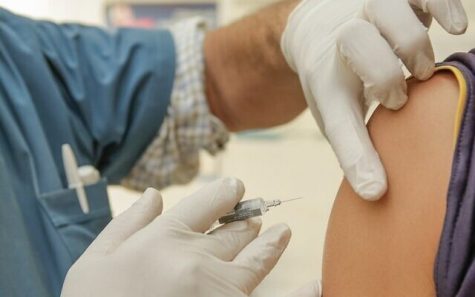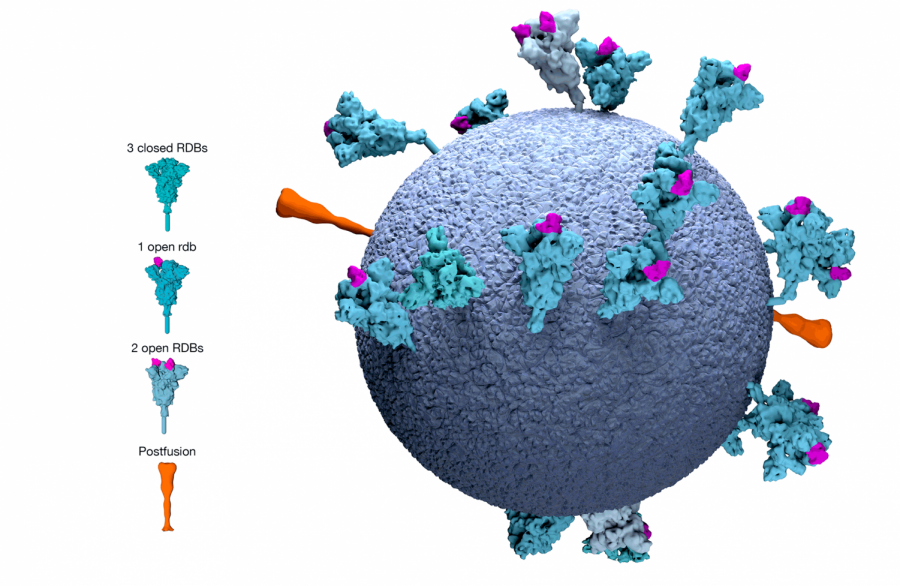Developments on Multiple COVID-19 Vaccines
MRC Laboratory of Molecular Biology
Image created to illustrate Pfizer Vaccine
November 20, 2020
News on COVID-19 has been pretty negative lately, especially with the return to the purple tier for the state of California. However, there is good news! Two companies, Pfizer and Moderna, have released data on the COVID-19 vaccines they have been working on developing. They appear to be extremely successful.
Pfizer released their data last week, which showed that their vaccine has been more than 90% effective. Though this is positive news, it does not mean that it can be distributed quite yet. The company says that they have achieved sufficient safety submit it to the FDA for review.

However, there is a big concern some people have with Pfizer’s vaccine: It has to be stored at -94° Fahrenheit, which is very low and abnormal for vaccines. Many pharmacies and clinics do not have access to supplies that would be able to sustain this temperature. It is expensive to obtain freezers that would be able to go to a temperature so low, and it would be an impractical purchase because most vaccines are held at 36-46° Fahrenheit.
Not only does this pose an issue regarding storage, but it would also make distribution extremely difficult.
This doesn’t mean that the vaccine won’t be able to be distributed, though, it just poses a bit of a challenge. But has anything over the past 7 months not been a challenge?
Thankfully, news of a second vaccine created by Moderna has also been released. This vaccine has been shown to be 95.5% effective. Moderna wants to obtain more data regarding safety before they apply for FDA authorization.
Moderna’s vaccine only has to be stored at -4° Fahrenheit, which is a major improvement from Pfizer’s requirement. This will be much easier to achieve.
Now, you might be wondering, when exactly will these vaccines be distributed to the public? Well, there are a lot of different answers to that question, and no one seems to know which one is correct.
It depends on a lot of different things, such as the FDA’s opinion, determination of the order of distribution, and the CDC’s opinion.
Some have said that the vaccine could be distributed by late December. This would likely be only to a very specific group of people, such as health-care professionals and/or immunocompromised people.
Mass distribution to the public would most likely occur in Spring of 2021, at the soonest.
Distribution is definitely a major point of stress for people. High school student Jonah Jimenez believes that “[the scientists won’t] have enough to be distributed” and that priority will be given to “celebrities and athletes” so that they can “keep producing movies and games.”
Even if the vaccines are able to be successfully distributed, it is not guaranteed that enough people will be willing to take them. There are apprehensions and concerns regarding the safety and effectiveness of the multiple COVID vaccines.
In a survey (review a copy here) that 6 high school students answered, 66.7% had heard the news of the Pfizer and Moderna vaccines. Out of those 6, 66.7% also said that they planned on getting the vaccine when it was made available to the public. 33.3% said that they might wait a little longer after it was made available to them to see how it goes.
It appears that teenagers don’t have too many specific concerns, as ERHS student Jamal Karim said that he had no concerns “specifically regarding the vaccine itself” and believes that it will be okay “as long as people follow procedures.”
Some possible concerns that have arisen are “what chemicals did [the scientists] use” and “how long did they test [the] vaccines”, as brought up by Jimenez.
Besides safety of the vaccine, effectiveness is another factor in people’s decision to get vaccinated or not.
Karim thinks that with the use of vaccines, eventually “quarantine, social distancing, [and] masks should go away with time.”
Like many others, though, he believes that seeing a significant decrease in the infection rate would “probably take a good amount of time.”
COVID has proved to be fast at progressing and slow at being controlled, so only time can tell how the addition of vaccines will effect COVID’s rate of infection.
There is still a long way to go in fighting COVID, but the development and success of these vaccines is a step in the right direction. Keep your spirits up and remember to follow social distancing rules, wash your hands, and wear a mask!


